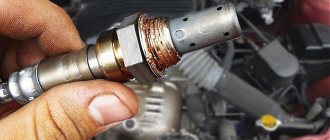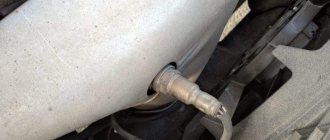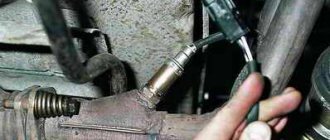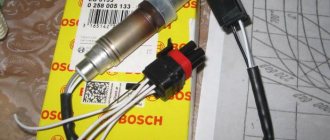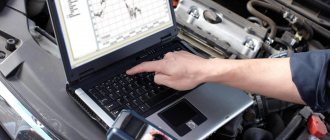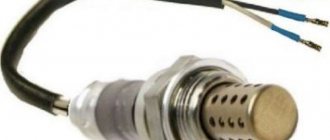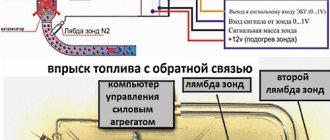The lambda probe has an important function, but few people are aware of it. It is important to find out in advance what it is for, how it works and how much it costs if replacement is necessary.
The lambda probe is just as important as other sensors in the car. Its function is to measure the oxygen concentration, which allows for ideal combustion of the mixture in the engine. Lambda probe is also known as oxygen sensor.
What is a lambda probe
The lambda probe is used to check the quality of combustion of the fuel mixture, in other words, it measures the amount of residual oxygen in the exhaust gases. This means that if there is a lot of O2 in the exhaust gases, then there is excess air in the combustion mixture, but if there is little oxygen, then this is a good sign and the mixture in the engine is optimal. This detail will also be important for those who have a clean environment as a priority.
For non-experts, it should be noted that in a gasoline engine the mixture must be stoichiometric: one gram of gasoline should be burned for every 14 grams of air. This proportion must be maintained, otherwise excessive oxidation of hydrocarbons inside the catalyst will occur.
To start measuring O2, the lambda probe needs to reach a temperature of about 340 degrees Celsius. For this reason, the sensor is always subject to electrical resistance to heat it up.
Installation of the blende
If the sensor fails, it cannot be repaired, and you can remove the lambda probe or replace it with a new one (which is quite expensive, especially for some car models). You can also install a lambda snag. The second method is often chosen because of its cheapness and simplicity. The essence of a small mechanical device is that it sends a signal to the ECU that is similar to a working one, so that the computer thinks there are no deviations. Of course, in this case, the quality of the fuel assembly drops sharply and the exhaust gases become less environmentally friendly.
Types of decoys for a lambda probe:
- A mechanical “plug”, inside which there is a smaller version of the catalyst, which slightly cleans the exhaust gases. It costs much less than a conventional catalyst, and is also versatile - suitable for almost any car;
- Electronic deception. This term refers to the reprogramming of the ECU, for example, to the Euro-2 standard, which reduces or completely eliminates the environmental requirements of a particular machine for the composition of the fuel-air mixture.
The goal of either option is to make the control unit think that the oxygen probe readings are normal.
Types of lambda sensors and what they are needed for
There are two types of lambda probe:
- Narrowband: It is less accurate, but cheaper.
- Wideband: more accurate and expensive.
The lambda probe has two functions, both of which are of fundamental importance. One is to analyze and the other is to control and inform the vehicle's "engine brain" so that fuel combustion occurs perfectly.
Two functions of the lambda probe:
- Control task: The lambda probe is located in front of the catalytic converter and analyzes the amount of O2 in the air. In this case, it acts as a sensor.
- Information task: it is the sensor that sends the recorded data to the engine control unit of the car, which acts in accordance with the recorded oxygen. For its part, the engine tries to achieve the ideal mixture and calculates the exact amount of fuel to be injected into the cylinders to ensure maximum efficiency.
ELM327 how to use
As mentioned earlier, using any ELM327 adapter you can diagnose the engine, and higher quality models with the appropriate software can show errors in all systems. But if the car does not show errors, this does not mean that it is working properly. Errors appear when the car is completely unwell and cannot be operated without repairs, but borderline conditions, when the error has not yet occurred or has been reset, can be tracked using parameters.
ELM327 programs.
Any program that works with ELM327 and can display engine operating parameters is suitable for diagnosing a car; we will consider working with the Car Scanner program. And so you inserted the adapter into the OBD2 connector, turned the ignition key and the car did not start. We connect the phone to the adapter. If the first stage has passed, we consider the adapter CONDITIONALLY serviceable. The next step is to connect the ELM327 to the vehicle's EBU. If the connection fails, it means your car is old and requires a special connection initialization line (look for information on the Internet using the corresponding request) or your adapter is faulty (which is unlikely, since faulty adapters jam, fall off, distort information or interfere with engine operation, but they connect ). Test operation with another known-good adapter.
ELM327 battery.
And so while the ignition is on and the car is not started, we look at the battery voltage. If the voltage is in the range of 12.4-12.7 Volts, the battery is working properly. If the voltage is lower, for example 11.8 Volts, it means either the battery is old and will die soon, or the attached electronics (radio, cameras, recorder, antenna, GPS tracker, alarm) are not connected to the car correctly and you have a high leakage current when the car is not running . Next, turn on the battery voltage graph and start the car. At this moment, the voltage should rise to 13.8 - 14.5 Volts, depending on the car model. If the voltage is below 13.8 volts, the generator does not charge the battery sufficiently; if it is more than 14.5 volts, overcharging occurs, which will eventually damage the battery. If the voltage remains 12.5 volts, then the generator is not working. In the graph we see a car that has not been used for half the winter, the battery is discharged, but it started up successfully and the battery is charging.
ELM327 absolute pressure in the intake manifold.
Then the car is not started yet, we look at the “absolute pressure in the intake manifold” data. It should be 97 kPa - this is normal atmospheric pressure outside (check the weather forecast). If the numbers are very different, it means the sensor is faulty (or you are very lucky and you are high in the mountains). We start the car - on a working engine without load (headlights, heater, heated windows and audio system are turned off), the pressure should drop to 27 kPa and level off at 30 kPa. The higher the pressure in the intake manifold at idle, the worse the condition of the engine. For foreign cars, 34 kPa is not very good, 40 kPa means the engine is not working properly. For domestic cars, the pressure in the intake manifold is up to 40 kPa within normal limits; if 44 kPa, the engine is not working properly. Weak fluctuations in pressure in the intake manifold at idle indicate problems in the ignition system, and significant fluctuations indicate poor condition of the cylinders or tightness of the cylinder head (compression measurement required). When you press the gas pedal sharply, the pressure should equal the atmospheric pressure of 97 kPa, then return to normal at 30 kPa. The slower the return to 30 kPa occurs when the gas pedal is released, the worse the condition of the engine. On a dead engine, ELM327 will simply show an error.
ELM327 long-term fuel correction.
Then the car is started, we look at the “long-term fuel trim” data. On a working car, my value is 1.5% and can fluctuate up to 5%, plus or minus, and depends on the quality of gasoline and operating conditions. Long-term fuel trim values of 5 to 10% are bad (watch the readings over the course of a month, maybe the car has eaten something wrong). Long-term fuel trim values greater than 10% indicate a malfunction of the injection system. On the positive side the mixture is too lean, on the negative side the mixture is too rich. I'm talking about a malfunction with which you can drive. If the long-term fuel correction exceeds 20%, the engine malfunction light will come on, ELM327 will show you an injection system error, and that means the shaggy, furry animal SCRIBE has come to you.
ELM327 intake air temperature.
The next intake air temperature sensor should work like a thermometer. On a cold car, if it is -10 degrees Celsius outside, the sensor should show -10 degrees Celsius, then the car warms up, it becomes warm under the hood +30 degrees Celsius, the sensor shows the intake air temperature of +30 degrees. If the sensor distorts the readings, the EBU, based on its readings, will prepare the wrong mixture of gasoline and air and you will get excessive fuel consumption. If the sensor is faulty, the engine will operate at the values from the table in the EBU, and an error will appear on the instrument panel.
In general, the injection engine will operate with any faulty sensors with an illuminated error message, receiving data from calculation tables in the EBU memory. The only sensor in the event of a malfunction that prevents engine operation is the crankshaft position sensor.
ELM327 coolant temperature.
The next parameter we look at is the coolant temperature. This parameter is very important for engine operation, so its readings are displayed on the instrument panel. An engine temperature that is incompatible with its life lights up a separate light on the instrument panel and indicates the impossibility of continuing further movement without dire consequences for the engine. And believe me, this is serious for injection engines. So, the data on the coolant temperature from the EBU that the ELM327 will show you is much more accurate than on the instrument panel. The coolant temperature on a cold car corresponds to the ambient air temperature, and then smoothly and evenly rises to the optimal engine operating temperature of 90 degrees Celsius and is then maintained around this value. If you see any jumps in the graph while the car is warming up, the sensor is faulty and may fail you in the near future - it needs to be changed. If the sensor is dead, ELM327 will show an error.
ELM327 engine speed.
Another parameter that is duplicated on the panel of your car is engine speed. And the ELM327 readings received from the EBU will again be more accurate. On a cold car, the engine starts at 1200 rpm and then gradually, as it warms up, reduces the value to 800 rpm at idle. As you can see, on a warm, working car, the engine idle speed readings fluctuate by 10 units from 790 to 800 rpm. If the engine idle speed reading fluctuates significantly more and you hear that the speed is floating, check the idle speed sensor and the throttle position sensor. If any of these sensors died, ELM327 will show an error for this sensor.
ELM327 oxygen sensor.
Then, with the car warmed up, the catalyst starts working. And we look at the readings of two sensors simultaneously: “oxygen sensor 1 voltage”, which is located before the catalyst and “oxygen sensor 2 voltage”, which is located after the catalyst. They need to be viewed in pairs on real-time graphs, without readings from other sensors, so that the graphs are updated as quickly as possible. The oxygen sensor 1 voltage reading should tend to a square waveform, and the oxygen sensor 2 voltage reading should tend to a straight line. You see a graph from a recording, so there is not enough data there to construct a square waveform. The more the data from sensor 2 repeats the data from sensor 1, the worse the performance of the catalyst. If ELM327 generates an error on the first or second oxygen sensors, this may indicate three malfunctions and one failure. The first reason is that the catalyst has failed and needs to be replaced. The second reason is that the exhaust system is not sealed, the catalyst is working properly and the burnt holes in the exhaust system need to be welded. The third reason is that one of the sensors has failed and needs to be checked and replaced. Fraud - They knocked out your catalyst and installed a low-quality fake instead of an oxygen sensor. Here you need to look at the mileage of the car. With proper operation in gentle conditions, the service life of the catalyst is 200 thousand kilometers. When operating in difficult conditions and on poor fuel, the service life of the catalyst is up to 100 thousand kilometers. If your mileage is 300 thousand, and the graphs are ideal, then you have a decoy instead of an oxygen sensor, which generates such a signal.
ELM327 ignition timing.
The next parameter is “ignition timing”. The ignition timing is set by the EBU and depends on the engine operating mode; its values are constantly changing. At idle speed on a warm engine it should be 10 degrees. At idle, my ignition timing ranges from 6 to 9 degrees, and when driving, depending on the load, its value is from 5 to 35 degrees. By changing the ignition angle values, the engine EBU tries to obtain minimal engine detonation. If you have strange ignition angle readings on the ELM327 or engine detonation is observed, you need to diagnose the ignition system - coil spark plugs, and also check the serviceability of the knock sensor.
ELM327 Car Scanner.
Now regarding the Car Scanner program. It records only those parameters that are currently displayed on the phone screen and related to it. That is, if you switched the display from one parameter to another, the recording of the first parameter will most likely be interrupted and there will be a gap on the graph until you see this parameter on the screen again. In justification, I can say that even Launch devices can display up to 6 parameters simultaneously.
Shutdown
The car owner may be wondering what will happen if he turns off the lambda probe himself. This is theoretically possible, but highly undesirable. If you turn off the lambda probe, the ECU will turn on the autonomous mixture supply mode. Over time, this will lead to various problems - carbon deposits on the pistons, catalyst, valves, and so on. All this can ultimately lead to the need for major repairs.
When removing the catalyst, you can turn off the lambda probe using software. The engine program will adapt to work without a sensor. Many car service centers offer a service to disable the oxygen sensor.
Diagnostic features
Sometimes other malfunctions unrelated to this are mistaken for the need to disable the oxygen sensor. It follows from this that before removing it, you need to conduct a thorough diagnosis using a scanner. The computer will show whether the problem is really in the probe, or whether other defects or a combination of them are causing the malfunction.
Of course, there is the simplest diagnostic method, which consists of simply disconnecting the probe and checking the quality of the car’s operation without it. It is expected that when the sensor is removed, the engine will run worse or not start at all. If there are no changes, it means that the oxygen sensor has been faulty for a long time and does not respond to exhaust emissions properly.
The most common problems with the lambda probe
Disabling this component is extremely negative for the car because it will lead to serious consequences. If there is an imbalance in the mixture, it can be very costly for the vehicle owner.
What happens if there is too much or too little oxygen in the mixture?
If there is little oxygen, then the fuel does not burn as it should. If this happens, then the exhaust gases can be seen releasing soot.
If there is a lot of oxygen, this is also harmful to the engine. This means combustion is not ideal. Nitrogen oxide will be displaced and the engine may stall.
Without a doubt, the lambda sensor is an important part of the car's operation, as it monitors the efficiency of the engine by controlling the mixture of air and fuel. It is responsible for delivering the exact amount of fuel to the cylinders to keep the engine running at peak efficiency.
If the lambda sensor does not work properly, the vehicle's fuel consumption will be reduced and the reduction in pollutant emissions will not be controlled and will not comply with current regulations.
A faulty lambda sensor can result in mechanical problems, higher repair costs, increased fuel consumption and fines.
This component requires maintenance and, if necessary, replacement. According to experts, the average service life of a lambda sensor is about 180,000 kilometers.
Disabling lambda at the software level
The most correct option is considered to be not physical, but software removal of the probe. To do this, you need to flash the car’s electronics to meet the Euro-2 environmental standard. While fakes only imitate work, chip tuning has the following advantages:
- Improved traction at low speeds;
- Increased engine torque and power;
- Increased accelerator pedal responsiveness;
- Reduced fuel consumption;
- General improvement in the dynamic characteristics of the machine;
- Improving the smoothness of gear shifting;
- Optimizing engine performance when the air conditioner is on.
The price necessarily includes preliminary diagnostics of the engine; the exact prices are set by the technician after inspection and depending on what electronic control unit is installed in the car and what is required from the program.
The Muffler Master car service center in St. Petersburg professionally deals with issues of the vehicle exhaust system. We eliminate any malfunctions in a short time, carry out diagnostics, and help with choosing the most suitable repair options. We can quickly remove the lambda and install a blende, and also provide other services for repairing and tuning the car exhaust system! Call the number indicated on the website and we will advise you on any issue!
Where can I buy
Spare parts and other products for the car are easily available for purchase at auto stores in your city. But there is another option that has recently received significant improvements. You no longer need to wait a long time for a parcel from China: the AliExpress online store now offers the opportunity to ship from transshipment warehouses located in various countries. For example, when ordering, you can specify the “Delivery from the Russian Federation” option.
Follow the links and choose:
| SPEEDWOW 4-Wrie Universal Lambda Oxygen Probe for Toyota Chevrolet | O2 Lambda Oxygen Sensor for VW Jetta, GOLF Beetle Skoda 1999-2005 | Lambda oxygen sensor for Lada, Niva, Samara, Kalina, Priora, UAZ, Chevrolet |
| Podofo 8G, 128G car multimedia player | Car radio Podofo, 2 DIN, 2.5D, GPS, Android, navigation, 7 inch screen | Essgoo, Android 9, radio, Bluetooth |
Oxygen sensor
Modern cars contain components that clean the exhaust from substances that are harmful to the environment.
In particular, catalysts and the first oxygen sensors are considered one of such devices. Their job is to analyze the percentage of oxygen in the gases emitted by the engine and transmit this information to the system so that optimal (stoichiometric) conditions can be created based on it. The lower oxygen sensors check the catalyst and also notify the system about its condition. If the element is faulty, the Check Engine icon appears on the dashboard, thereby notifying the driver of the problem. It’s easy to solve – remove the catalyst in Moscow at our service.
When all components are in good working order and perform their functions well, removing the catalyst is not necessary. However, to solve special problems (preparing for long trips, country trips) or when these components are at the limit of their capabilities, there is a need to deactivate them.
